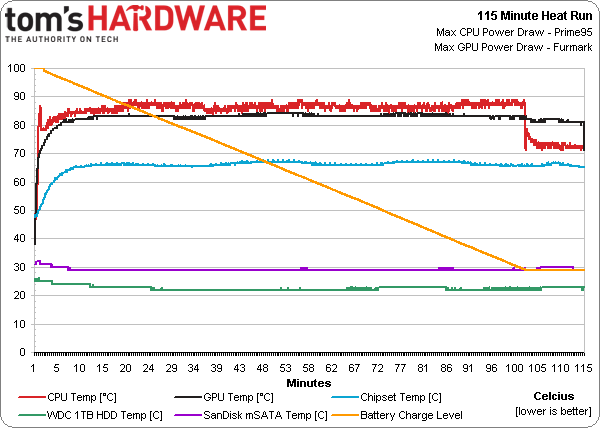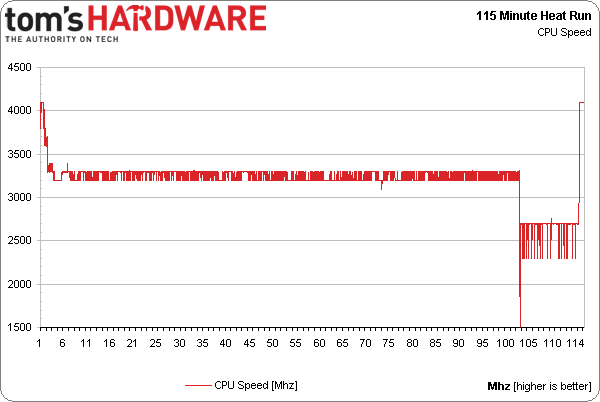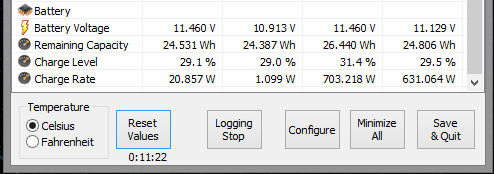MSI GT70 Dragon Edition 2 By Xotic PC: Haswell Goes Mobile
MSI's GT70 Dragon Edition 2 is in the lab, tuned up by Xotic PC. Sporting a Haswell-based mobile Core i7-4930MX CPU, Nvidia's GeForce GTX 780M, and a luxurious 17.3" FHD screen, this is one heavy-duty gaming notebook. At more than $3000, it should be.
Synthetic Heat Run And The Impact Of MSI's NOS
In order to really push the GT70 to its limits, you already saw us fully load its Core i7-4930MX CPU and GeForce GTX 780M GPU. Each part is kept at its factory-overclocked frequency, since Xotic PC fully guarantees those settings. The goal was to run the machine until its internal and external temperatures maxed out. The only reason to end a run early would be a hardware failure.
There's a lot going on in this chart. First, turn your attention to the red line, which represents CPU temperature. As the chip gets past that initial 28-second burst of Turbo Boost speed, it quickly spikes to just over 85 degrees Celsius, then quickly falls below 80 as the fan kicks in and the CPU frequency drops to about 3.3 GHz. The temperature stays below 90 degrees for the entire run, showcasing the effectiveness of MSI's cooling implementation, even in the face of Haswell's documented heat issues.
Next, we look at the yellow line illustrating the the battery's charge level. As described earlier, the GT70 employs a "feature" called NOS that draws extra power from the battery if the platform needs more than the AC adapter can provide. At 30%, NOS shuts down and performance is pulled back. Now we see what happens when NOS is disengaged. Looking at the yellow battery line, the discharge rate is even over time until hitting 29% at the 105-minute mark. The transition out of NOS is less dramatic than we expected. The CPU dips down to 800 MHz, then quickly spins back up to about 2.6 GHz. GPU power consumption does not change at all, and the battery charge rate is zero.
When NOS disengages, draw from the walls rises from 179 W to 203. Adding in 10% losses to heat, we'd expect a 180 W power supply to pull 200 W from the wall. We don't understand why MSI doesn't allow its adapter to run at full power all of the time.
The other thing we see when NOS throttles the processor down is the influence of the heat pipe joining the CPU and GPU. Even though the GPU load does not change significantly, the GPU temperature goes down as the CPU generates less heat. MSI's updated thermal solution is now a proven improvement.
The GT70 keeps an overclocked GeForce GTX 780M under 85 degrees for the entire stress test, performing excellently. Intel's chipset does warm up, but stabilizes in the mid-60-degree range. Both storage sensors actually register lower temperatures once the fans kick in, showing excellent separation from other heat sources in the machine, along with commendable overall cooling performance.
The chart below contains another run that we completed with the new BIOS. We had to extend this one to 140 minutes due to improvements in the NOS function.
Get Tom's Hardware's best news and in-depth reviews, straight to your inbox.
Temperatures and performance during most of the test remain unchanged with the new BIOS. With the system’s power adaptor now providing 187 W, the battery lasts around 30 minutes longer than the first test. Once NOS disengages and the CPU pulls back to 800 MHz with spikes to 3.2 GHz, the chip's thermals fall off quickly. The effect of the single CPU/GPU heat pipe is even more pronounced since the CPU speed (and therefore, heat) is much lower with the newer BIOS.
Taking a closer look at CPU clock rate during the heat run, we see that the machine enjoys a bit of Turbo Boost acceleration at the beginning, settling around 3.3 GHz once the thermal situation dictates as much. If we weren't also applying a GPU load, the GT70 would likely run at this frequency indefinitely. But because the graphics module is causing battery drain, we also see the impact of NOS disengaging around the 105-minute mark. The dip goes as low as 800 MHz and recovers to 2.6 GHz. Once Prime95 is shut down at 114 minutes, the system jumps back up to 4.1 GHz.
Below is the frequency result for the same run with MSI's newer firmware.
Clock rates remain the same. Once NOS is turned off and the system no longer draws battery power, there's another drop to 800 MHz with quick spikes up to 3.2 GHz. In this situation, the new BIOS does not improve system performance.
The GT70's palm rest and keyboard remained cool throughout testing. The only areas where we felt heat were one corner by the LCD hinge and right above the side exhaust vent. Those spots get warm, but it's still possible to leave your hand there without getting uncomfortable. Plus, those aren't parts of the notebook you'd normally be grabbing. Right-handed users will have no issues with the exhaust heat, though lefties might be more likely to have their mousing hand in front of the side vent.
In the shot above, you can see the GT70's charge rate with NOS disabled and FurMark running. The system is pulling 187 W from the wall, and the battery is being charged at close to 21 W. Below, we see the CPU's power consumption.
If we take the CPU draw of about 16 W and add it to the 21 W being charged, we're able to surmise that about 37 W are available to the CPU when the GPU is fully loaded. A A 37 W Core i7-4702MQ should never have to use NOS to draw power from the system’s battery. A 47 W Core i7-4700MQ, -4800MQ, or -4900MQ is less likely to use NOS, though there are still 10 W that need to be made up somewhere else in the system. With the Core i7-4930MX and GeForce GTX 780M, you have 20 W needed from the battery under full CPU and GPU load. To really get the most out of the GT70 in this power-hungry, overclocked configuration, you really need a larger power adapter, pure and simple.
In order to test how NOS might behave with another CPU, we used Intel's Extreme Tuning Utility to limit the amount of power the CPU is allowed to use. We then played Crysis 3 for 15 minutes and compared the results. At full power, the machine used 4% of its battery in that 15-minute run. Limited to 47 W, the machine used 3%. Limited to 37 W, it consumed 2%. Only at 37 W and a stock GeForce GTX 780M (not overclocked) were we able to get around NOS, still averaging 38 FPS using Very High details at 1920x1080.
Overall, the GT70 performs really well until its battery drops below 30% charge. Because NOS deliberately uses the battery for extra power, expect performance to drop once NOS is disabled. Putting extra wear on a system’s battery during intense plugged-in gaming sessions is not what we would call a desirable feature.
This wear is exacerbated by an AC adapter the delivered less power with MSI's original firmware. With the updated BIOS, battery wear in normal gaming environments is greatly reduced. Titles like Crysis 3 place a taxing load on both the CPU and GPU, compelling NOS to tap into the battery if you're running a high-end Core i7-4930MX and GeForce GTX 780M combination.
We hope MSI continues to optimize its battery situation through additional BIOS updates. We also hope MSI considers bundling a larger power adapter to minimize reliance on NOS. Further, we wish there was a way to completely disable NOS so that you'd have the option to maintain a fully-charged battery.
Current page: Synthetic Heat Run And The Impact Of MSI's NOS
Prev Page Turbo Boost Behavior And Throttle Testing Next Page Battery Life, AC Draw, And Charge Rate-
cobra5000 My A10 laptop w/7660g may not have the specs but it plays great and only cost me $505.99.Reply
How about that for bragging rights! -
sha7bot Forbes magazine posted a great article on this system, as well. Seems like Alienware, ASUS, and Clevo have some serious competition.Reply -
lunyone I have an AMD a6 quad core CPU w/7670 dGPU that cost me <$400 and it will game okay for most things. Of coarse it's no screamer unit, but for 95% of what I do it works just fine. Yes I would have loved to had a better system for light gaming, but my laptop fit my budget. I wish that we got off this 1366 x 768 resolution and started out at 1600 x 900 for 11-15" laptops as a minimum, but that is just me.Reply -
Ducktor Please remove the term W/h from the text as well as "Watt per hour" from the graph on page 14. This unit is meaningless! 1W = 1J/s which is already a rate of power consumption. Dividing this unit by an hour yields 1W/h = 1J/3600s^2 which actually implies an acceleration in power consumption! Such mistakes are really hard to accept on a technical site like Tom'sReply -
danwat1234 Yea, the 180w ac adapter in this laptop, and also in the Gt60-2od laptop (the 15" version of this laptop) should really come with a ~240w AC adapter like what the Asus G750 has, but it doesn't. So they made NOS to adapt.Reply
It is unfortunate. What if I want to crunch on the high-end CPU and the GPU 24/7 for some reason? Can't do it with a 180w AC adapter.
To those thinking that the built in single fan isn't good enough, it is a 12V fan! I have never seen a 12V fan in a laptop before but this one has it. The Coolerboost feature ramps up the fan RPM to maximum and really keeps the temperatures down.
There are some reports of bad paste jobs so if you are having high temps, that may be the reason. Call up MSI to verify that your warranty will not be void and then repaste it. MSI is cool in that they'll usually allow you to take off the heatsink whereas Asus won't.
Thanks Tom's for making a much better review than what Anand did!
So on page 14, the max power draw from the battery when the laptop is unplugged and you are gaming is only 85 watts? That must mean that the dedicated graphics is shut down and the HD4600 is only on? Can you have the 780m when on only battery power? -
luckiest charm I would feel awkward using this machine in trains, at relative's places, or anywhere else I can be spotted on so I don't become a laughing stock. :PReply -
custodian-1 With the problem with cell phones being stolen I would not take something out of the case.Reply -
boro169 I think it should be noted that derived notebooks from this like deviltechs are much cheaper. the starting point of msi is 2400 euros in my country and deviltechs modified msi cost me 2050 with a 250gb samsung 840 and a 1 tb 5400 hdd and the 780m.. yeah it doesn't have the steelseries keyboard it has de gt60 blue blaclight one but...Reply
for those talking about its not for hardcore gamers... I think they are wrong because i can't take my cosmos II tower with the 3930x and my titan on my back when i visit my girlfriend on train a 300km away from my home... and not everybody can have two of those beasts.. the desktop is always better but you can't drag it always with you to trips...
for the one talking about being scared of being robbed... I don't know why he walks on the streets wearing a wallet you COULD be robbed... or a plane could crash on your head.... ¬¬ then nobody would buy an smartphone. because to use it indoor and using outdoors and old nokia because if it is robbed its not an expensive lose....
if you at least talked about the processing power lose when not wall plugged or so that would be a reasonable comentary... -
warezme You know the new Haswell GTX780m Alienware models have been out for awhile. You should have done your comparison with one of those. LIkely more expensive but more direct comparison.Reply






